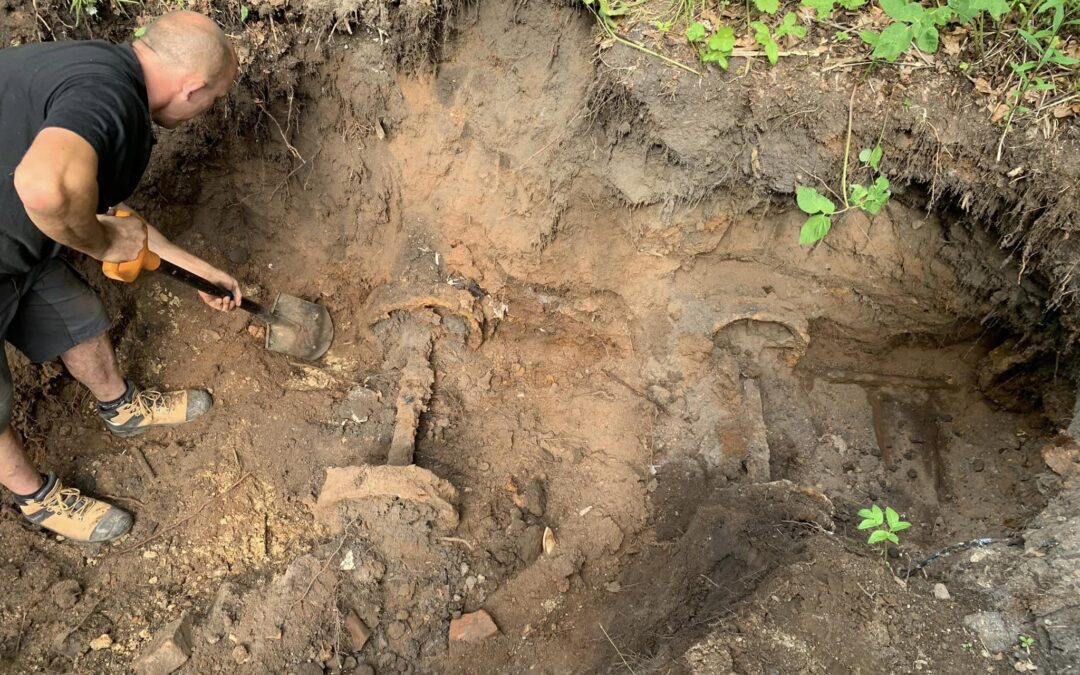Excavation yesterday took place of a rail line discovered at the site of the wartime headquarters of Nazi Germany’s military high command, located in what is now Poland.
Some, including the museum at the site, have speculated the trail could lead to the Amber Room, a priceless chamber that was looted from Russia by the Germans during the war but then disappeared in 1945.
Dzisiaj w kompleksie bunkrów w Mamerkach na Mazurach odsłonięte zostanie odkryte kilka tygodni temu torowisko wąskotorówki. Jest też dużo śmieci z czasów II WŚ. @RMF24pl pic.twitter.com/UgrmePopwl
— Piotr Bułakowski (@PiotrBulakowski) July 4, 2023
In early June, the World War Two History Museum in Mamerki, which oversees a complex of bunkers that functioned as the headquarters of Germany’s Supreme Command of the Land Forces, announced that a local historical society had discovered fragments of a railway line and a wagon.
Previously it had not been known that there was a railway of any sort in the complex, and the museum noted that the tracks and wagon had been deliberately covered up under 1.5 metres of earth. That led them to ask if the discovery could be related to the Amber Room.
SENASACYJNE ODKRYCIE W MAMERKACH!!!!. Stowarzyszenie Historyczno – Eksploracyjne Jaćwież – Ełk, Augustów a konkretnie Karol Konratowski odnalazł w Mamerkach fragment nieznanego dotąd torowiska! Czyżby Złoty Pociąg z Bursztynową Komnatą? pic.twitter.com/BNFlToh9NR
— Mamerki Bunkry (@MamerkiMuzeum) June 6, 2023
Originally created at Charlottenburg Palace in Berlin in the 18th century, the Amber Room was later gifted by King Frederick William I of Prussia to Tsar Peter the Great of Russia, who installed it at the Catherine Palace, near St Petersburg.
In 1941, after Nazi Germany had invaded the Soviet Union, the room was looted by German soldiers and transported to Königsberg (now Kaliningrad), where it was stored in the castle. It remained there until the end of the war in 1945, at which point all trace of it was lost.
While it is possible that the Amber Room was destroyed by British bombing raids or Soviet artillery, some have speculated that it was secretly evacuated from Königsberg. However, despite various theories and purported leads, no trace of it has ever been found.

The Amber Room in the Catherine Palace, 1917.
Among the places that treasure hunters have previously suspected could be linked to the Amber Room is the bunker complex at Mamerki, which is just a few kilometres away from the “Wolf’s Lair” bunker that served as Hitler’s Eastern Front military headquarters during the war.
That is why last month’s discovery of rail lines in Mamerki – a huge complex that housed around 1,500 Wehrmacht soldiers – raised particular interest, reports broadcaster RMF24.
On 12 June, the museum in Mamerki announced that it had received permission from the local conservator of monuments and the state forestry service to excavate the area where the tracks were found. Digging took place yesterday.
Trwa odkopywanie resztek wagonika znalezionego w @MamerkiMuzeum. @RMF24pl pic.twitter.com/u0uyLJ3Nr7
— Piotr Bułakowski (@PiotrBulakowski) July 4, 2023
Są kolejne koła wagoników. Nie wiadomo ostatecznie, ile ich będzie. @MamerkiMuzeum @RMF24pl pic.twitter.com/31Tc1OsaJA
— Piotr Bułakowski (@PiotrBulakowski) July 4, 2023
The search turned up hundreds of items from the Nazi era, including a 1941 Rosenthal plate printed with a swastika, perfume bottles, a glass mug, and even a bottle of Maggi sauce with some of the liquid remaining inside.
The museum also announced that they had discovered four pairs of wheels from wagons that ran on the track. However, while they could see that the line runs further, they are currently unable to continue digging as it would damage trees.
“We won’t find out today how long the tracks are and where they lead. The secret remains a secret for now,” wrote the museum, whose director, Bartłomiej Plebańczyk, told RMF24 that further exploration work would now be needed.
Na razie talerze i perfumy w @MamerkiMuzeum. Kopiemy w poszukiwaniu dalszej części torowiska wąskotorówki. @RMF24pl pic.twitter.com/Ijk66BEjpa
— Piotr Bułakowski (@PiotrBulakowski) July 4, 2023
Kolejna porcja naczyń i butelek z kompleksu bunkrów @MamerkiMuzeum. W tym jest też MAGGI z resztką plynu. @RMF24pl pic.twitter.com/Hyg4z55NFI
— Piotr Bułakowski (@PiotrBulakowski) July 4, 2023
Main image credit: Mamerki Bunkry/Facebook

Daniel Tilles is editor-in-chief of Notes from Poland. He has written on Polish affairs for a wide range of publications, including Foreign Policy, POLITICO Europe, EUobserver and Dziennik Gazeta Prawna.




















